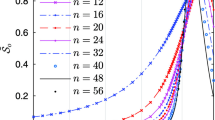Abstract
Recently, we demonstrated rigorously the stability of charge-stripe phases in 2D quantum-particle systems that are described by extended Falicov–Kimball Hamiltonians, with the quantum hopping particles being either spinless fermions or hardcore bosons. In this paper, by means of the same methods, we show that an arbitrary small anisotropy of nearest-neighbor hopping eliminates the π/2-rotation degeneracy of dimeric and axial-stripe phases and orients them in the direction of the weaker hopping. Due to the same anisotropy the obtained phase diagrams of fermions show a tendency to become similar to those of hardcore bosons.
Similar content being viewed by others
References
V. Derzhko and J. Jędrzejewski, Formation of charge-stripe phases in a system of spinless fermions or hardcore bosons. Physica A 349:511 (2005).
J. M. Tranquada, D. J. Buttrey, V. Sachan and J. E. Lorenzo, Simultaneous ordering of holes and spins in La2NiO4.125. Phys. Rev. Lett. 73:1003 (1994).
J. M. Tranquada, B. J. Sternlieb, J. D. Axe, Y. Nakamura and S. Uchida, Evidence for stripe correlations of spins and holes in copper oxide superconductors. Nature (Lond.) 375:561 (1995).
A. M. Oleś, Stripe phases in high-temperature superconductors. Acta Phys. Polonica B 31:2963 (2000).
N. G. Zhang and C. L. Henley, Stripes and holes in a two-dimensional model of spinless fermions or hardcore bosons. Phys. Rev. B 68:014506 (2003).
C. L. Henley and N. G. Zhang, Spinless fermions and charged stripes at the strong-coupling limit. Phys. Rev. B 63:233107 (2001).
R. Lemański, J. K. Freericks and G. Banach, Stripe phases in the two-dimensional Falicov–Kimball model. Phys. Rev. Lett. 89:196403 (2002).
R. Lemański, J. K. Freericks and G. Banach, Charge stripes due to electron correlations in the two-dimensional spinless Falicov–Kimball model. J. Stat. Phys. 116:699 (2004).
U. Brandt and R. Schmidt, Exact results for the distribution of the f-level ground state occupation in the spinless Falicov–Kimball model. Z. Phys. B 63:45 (1986).
T. Kennedy and E. H. Lieb, An itinerant electron model with crystalline or magnetic long range order. Physica A 138:320 (1986).
B. Normand and A. P. Kampf, Lattice anisotropy as the microscopic origin of static stripes in cuprates. Phys. Rev. B 64:024521 (2001).
B. Normand and A. P. Kampf, Supression of static stripe formation by next-neighbor hopping. Phys. Rev. B 65:020509(R) (2001).
M. Raczkowski, B. Normand and A. M. Oleś, Vertical and diagonal stripes in the extended Hubbard model. Phys. Stat. Sol. (b) 236:376 (2003).
V. Derzhko and J. Jędrzejewski, Charge-stripe phases versus a weak anisotropy of nearest-neighbor hopping, arXiv:cond-mat/0509698
L. M. Falicov and J. C. Kimball, Simple model for semiconductor-metal transitions: SmB 6 and transition-metal oxides. Phys. Rev. Lett. 22:997 (1969).
C. Gruber and N. Macris, The Falicov–Kimball model: A review of exact results and extensions. Helv. Phys. Acta 69:850 (1996).
J. Jędrzejewski and R. Lemański, Falicov–Kimball models of collective phenomena in solids (a concise guide). Acta Phys. Pol. B 32:3243 (2001).
C. Gruber and D. Ueltschi, The Falicov–Kimball model, arXiv:math-ph/0502041.
C. Gruber, J. Jędrzejewski and P. Lemberger, Ground states of the spinless Falicov–Kimball model. II. J. Stat. Phys. 66:913 (1992).
N. Datta, R. Fernández and Jürg FrÖhlich, Effective Hamiltonians and phase diagrams for tight-binding models. J. Stat. Phys. 96:545 (1999).
C. Gruber, N. Macris, A. Messager and D. Ueltschi, Ground states and flux configurations of the two-dimensional Falicov–Kimball model. J. Stat. Phys. 86:57 (1997).
J. Slawny, Low-temperature properties of classical lattice systems: Phase transitions and phase diagrams, In: C. Domb and J. Lebowitz (Eds.), Phase Transitions and Critical Phenomena vol. 11, (Academic Press, London/New York 1985).
T. Kennedy, Some rigorous results on the ground states of the Falicov–Kimball model. Rev. Math. Phys. 6:901 (1994).
V. Derzhko and J. Jędrzejewski, From phase separation to long-range order in a system of interacting electrons. Physica A 328:449 (2003).
R. T. Rockafellar, Convex Analysis, Princeton University Press, 1979.
Author information
Authors and Affiliations
Corresponding author
Additional information
PACS numbers: 71.10.Fd, 71.10.−w, 71.27.+a, 67.40.Db
Rights and permissions
About this article
Cite this article
Derzhko, V., Jedrzejewski, J. Charge-Stripe Phases Versus a Weak Anisotropy of Nearest-Neighbor Hopping. J Stat Phys 126, 467–505 (2007). https://doi.org/10.1007/s10955-006-9245-1
Received:
Accepted:
Published:
Issue Date:
DOI: https://doi.org/10.1007/s10955-006-9245-1



